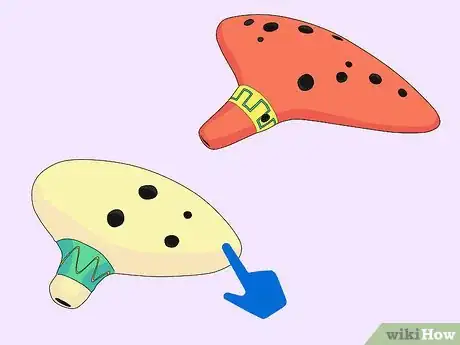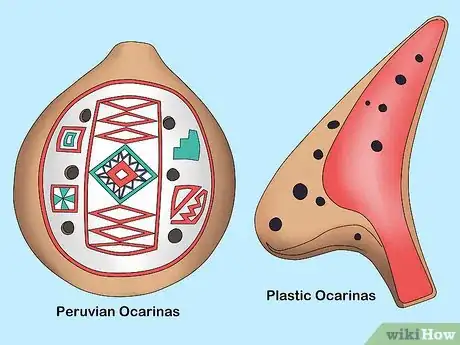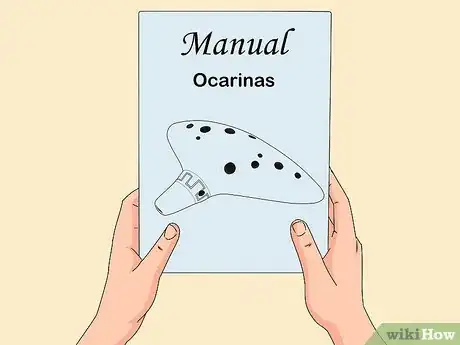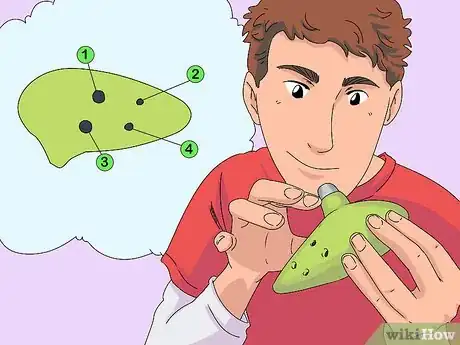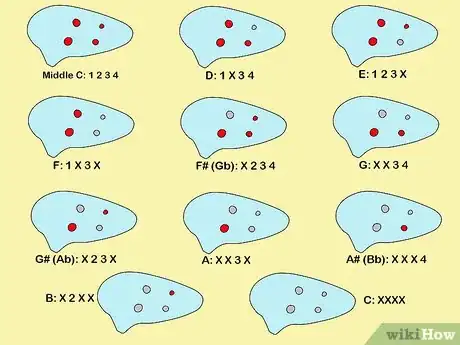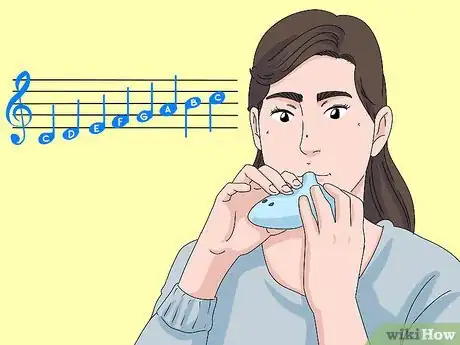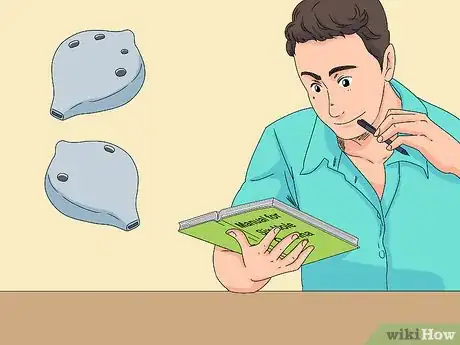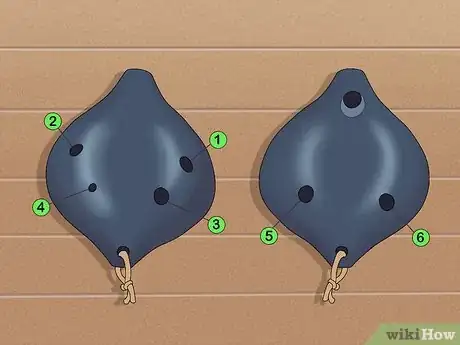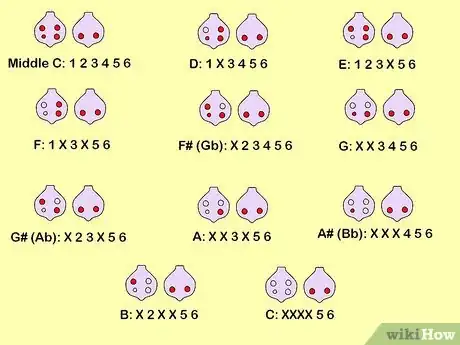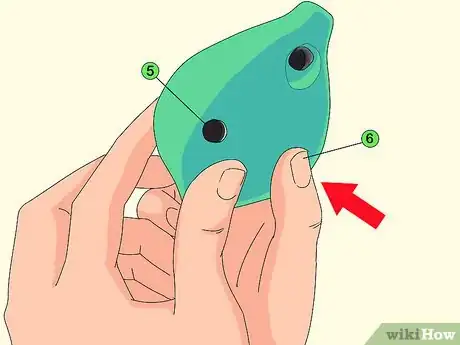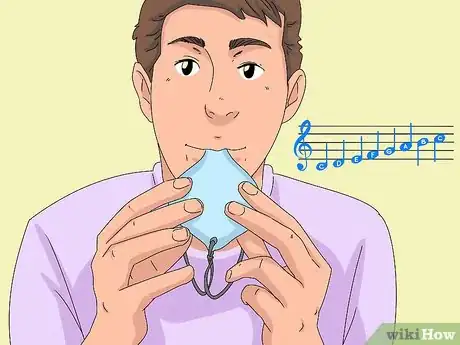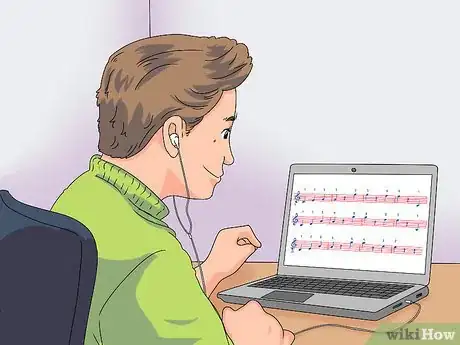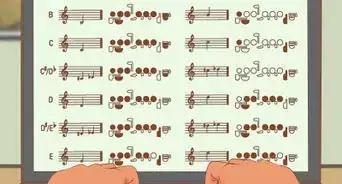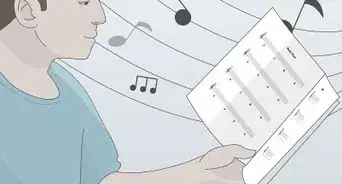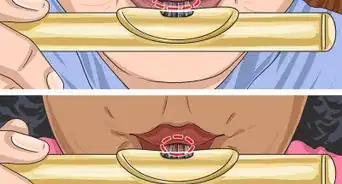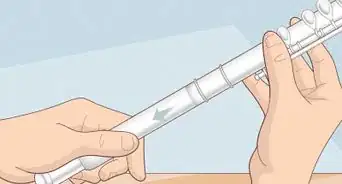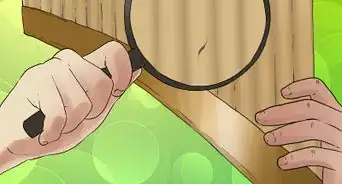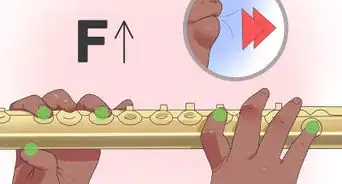wikiHow is a “wiki,” similar to Wikipedia, which means that many of our articles are co-written by multiple authors. To create this article, 32 people, some anonymous, worked to edit and improve it over time.
There are 9 references cited in this article, which can be found at the bottom of the page.
This article has been viewed 359,540 times.
Learn more...
The ocarina is an unusual wind instrument that comes in a variety of shapes and sizes. Despite how different they look, the ocarina and a recorder emit fairly similar sounds. You may be familiar with the ocarina as an instrument through a fandom of Nintendo's Zelda games. However you came to the instrument, the ocarina is a fun and easy way to play around with a melody.
Steps
Buying a Beginner’s Ocarina
-
1Shop for your ocarina online. Since it’s such a rare instrument, you’re going to be hard-pressed to find one in a music store. With a little research, you’ll find a wealth of online retailers who sell what you’re looking for—from Amazon to retailers who specialize in high quality ocarinas.[1]
- If you’re just learning how to play this instrument, don’t break the bank on your first ocarina. $20 to $60 should get you the perfect starter instrument.
- If you find you love your new hobby and want to invest in an instrument, high quality ocarinas can run as high as $500.
-
2Decide on a pitch range. Ocarinas don’t cover a wide range of sounds, like a piano does, so it’s important to choose an ocarina that’s going to play the pitch you want. In descending order from highest to lowest pitch range, you can find soprano, alto, tenor, and bass ocarinas.[2]
- The higher the range, the smaller the instrument, so keep that in mind when choosing your instrument.
Advertisement -
3Choose an ocarina style that best suits your skill level.[3] A four-hole or six-hole ocarina will be the best style to learn on, as they are generally inexpensive, light, and easily produce a wide range of notes with very few finger patterns.
- A four-hole ocarina can produce a basic scale of eight notes.
- A six-hole ocarina can produce a basic scale plus semitones.
-
4Avoid Peruvian and plastic ocarinas. Peruvian ocarinas are beautifully styled and detailed, so you may be tempted to buy one on aesthetics alone. However, they’re usually crafted with cheap materials, and don’t sound very good as a result. They’re more decorative than useful for playing purposes. Plastic ocarinas, although seductively affordable, are often “airy” and improperly tuned.[4]
Playing a Four-Hole Ocarina
-
1Check for a user’s manual. Sometimes, ocarinas come with an instrument chart or other instructions on how to play the instrument. If it did, study the chart to see which holes you have to cover to produce a specific note.
- If your ocarina did not come with a user’s manual, follow the instructions in the next step.
-
2Label and memorize the holes. You can produce a wide range of sounds by covering and uncovering different combinations of the four holes with your fingers. As such, you want to make sure that you have a labeling system that helps you remember which combinations produce specific sounds.[5]
- Put the ocarina’s mouthpiece in your mouth as though you were going to play it and look at the positioning of the holes from this perspective.
- In your mind, label the top left hole “1”, the top right “2”, bottom left “3”, and the bottom right hole “4.”
- Drill those hole positions into your head so that you can easily read these instructions for how to play scales.
- An “x” will be used to symbolize an open hole, meaning you should not cover that hole with your finger.
- So, for example, a Middle C is represented as 1 2 3 4. This means you should cover all four holes with your pointer and middle fingers while blowing through the mouthpiece.
- A D, on the other hand, is represented as 1 X 3 4. This means that all holes should be covered except for hole 2 — the top right hole.
-
3Learn your basic scales. Go through them slowly at first and try to memorize the finger patterns needed to create this progression of notes. Don’t worry about speed yet — just memorize how to play a scale. Use the following finger patterns to work through the scales:[6]
- Middle C: 1 2 3 4
- D: 1 X 3 4
- E: 1 2 3 X
- F: 1 X 3 X
- F# (Gb): X 2 3 4
- G: X X 3 4
- G# (Ab): X 2 3 X
- A: X X 3 X
- A# (Bb): X X X 4
- B: X 2 X X
- C: XXXX
-
4Practice your scales. The best thing you can do to become a proficient ocarina player is to be able to move up and down your scales. There are two things you want to focus on during this practice: 1) memorizing the notes produced by your finger patterns and 2) speed. The better you get at those two things, the more you’ll be able to enjoy the actual music you’re playing.
- A scale of C progresses thusly: C-D-E-F-G-A-B-C.
- Practice it going up (ascending) and down (descending). This is the basis for many pieces you will play.
-
5Familiarize yourself with musical notations. Everyone knows what musical notes look like, but being able to decode them into an actual song might be beyond your grasp. Although many people take lessons with professional teachers to learn musical notations, you can find many places online where you can learn how to read music for free. Once you can read music, you’ll be able to play along with the melodies to your favorite songs with your ocarina.
- You can find sheet music for your favorite songs either by purchasing books or by searching online.[7]
Playing a Six-Hole Ocarina
-
1Check for a user’s manual. Again, it’s always best to consult instructions for a particular instrument rather than general instructions. Study the chart to see which holes you have to cover to produce a specific note.
-
2Label and memorize the holes. Just like with a four-hole ocarina, the only way you’ll find any success playing this instrument is by memorizing how to produce a specific note. You need a labeling system — but this time, for six holes.[8]
- Put the ocarina’s mouthpiece in your mouth as though you were going to play it and look at the positioning of the holes on the top of the instrument from this perspective.
- In your mind, label the top left hole “1,” the top right “2,” the bottom left “3,” and the bottom right “4.”
- Then imagine the holes on the bottom of the instrument, which can be covered with your thumbs. Label the one on the left “5” and the one on the right “6.”
- Drill those hole positions into your head so that you can easily read these instructions for how to play scales.
- An “x” will be used to symbolize an open hole, meaning you should not cover that hole with your finger.
-
3Practice your basic scales. Even though the six-hole ocarina has two extra holes on the back, it uses the same basic system as the four-hole ocarina. The significant difference is that to produce the notes from the four-hole instrument, you must cover the two holes on the bottom while following the same pattern in the top four holes. Memorize this scale progression, beginning slowly again and focusing on familiarizing yourself with the notes. Use the following finger patterns to work through the scales:[9]
- Middle C: 1 2 3 4 5 6
- D: 1 X 3 4 5 6
- E: 1 2 3 X 5 6
- F: 1 X 3 X 5 6
- F# (Gb): X 2 3 4 5 6
- G: X X 3 4 5 6
- G# (Ab): X 2 3 X 5 6
- A: X X 3 X 5 6
- A# (Bb): X X X 4 5 6
- B: X 2 X X 5 6
- C: XXXX 5 6
-
4Learn how to use the two bottom holes. These holes raise the basic notes from the previous step by one step (a semitone) or by two steps (a tone). To raise a note by one step, begin with the fingering for the lower note as on a four-hole instrument, but cover hole 5 covered and leave 6 open. To raise a note by two steps, start again with the fingering for the lower note on a four-hole instrument, with hole 5 open and 6 covered.[10]
- A semitone raises a note to the next one up in the chromatic scale, eg: C→C#, Ab→A, E→F.
- A tone raises it up two steps in the same scale, eg: C→D, Ab→Bb, E→F#.
- For example, to play a C#, you would position holes 1-4 for a C (XXXX), then move up one step by uncovering hole 6, so that only hole 5 remains covered: X X X X 5 X.
- To easily move from a C to a D without having to move all of your fingers around, you would begin with a C (XXXX56) then move up two steps by uncovering hole 5, so that only hole 6 remains covered: X X X X X 6.
- This is a much easier transition for your fingers than XXXX56 to 1X3456.
-
5Practice your scales. The best thing you can do to become a proficient ocarina player is to be able to move up and down your scales. There are two things you want to focus on during this practice: 1) memorizing the notes produced by your finger patterns and 2) speed. The better you get at those two things, the more you’ll be able to enjoy the actual music you’re playing.
- A scale of C progresses thusly: C-D-E-F-G-A-B-C.
- Practice it going up (ascending) and down (descending). This is the basis for many pieces you will play.
-
6Familiarize yourself with musical notations. Everyone knows what musical notes look like, but being able to decode them into an actual song might be beyond your grasp. Although many people take lessons with professional teachers to learn musical notations, you can find many places online where you can learn how to read music for free. Once you can read music, you’ll be able to play along with the melodies to your favorite songs with your ocarina.
- You can find sheet music for your favorite songs either by purchasing books or by searching online.
Community Q&A
-
QuestionWhat materials are bad vs. good besides plastic?
 Community AnswerThere's really not a completely terrible material, just a bad maker. Plastic is a decent material, actually. Not advisable for beginners, though, because the higher notes sound really airy if you don't know much about ocarina. Ceramic is the most common. It has a clear tone if it is made properly. Great for beginners or professionals on a tight budget. Porcelain is the best material, it is usually for professionals and has a really clean and pure sound. Wooden is okay, just make sure it has a decent finish or else the wood will be ruined quicker. In order from worst to best: wooden without finish, plastic, ceramic/wooden with finish are about the same, then porcelain.
Community AnswerThere's really not a completely terrible material, just a bad maker. Plastic is a decent material, actually. Not advisable for beginners, though, because the higher notes sound really airy if you don't know much about ocarina. Ceramic is the most common. It has a clear tone if it is made properly. Great for beginners or professionals on a tight budget. Porcelain is the best material, it is usually for professionals and has a really clean and pure sound. Wooden is okay, just make sure it has a decent finish or else the wood will be ruined quicker. In order from worst to best: wooden without finish, plastic, ceramic/wooden with finish are about the same, then porcelain. -
QuestionI am having a really hard time finding good sheet music for my 12 hole alto C ocarina. What are some good sources to go to where I can always have a song to play and practice?
 Community AnswerYour ocarina has a wide enough range that almost any music written for a non-transposing melodic instrument (flute, oboe, alto or soprano recorder, or violin) music should work. You can find collections of folk music from many different countries in many thrift stores or online; google "solo folk music recorder scores free." Check out medieval music as well; look for soprano or alto solo collections and free scores at the IMSLP website. Search for all the above instruments, then pick the ones that look like they're in your proficiency range. I recommend starting with only one or two sharps or flats.
Community AnswerYour ocarina has a wide enough range that almost any music written for a non-transposing melodic instrument (flute, oboe, alto or soprano recorder, or violin) music should work. You can find collections of folk music from many different countries in many thrift stores or online; google "solo folk music recorder scores free." Check out medieval music as well; look for soprano or alto solo collections and free scores at the IMSLP website. Search for all the above instruments, then pick the ones that look like they're in your proficiency range. I recommend starting with only one or two sharps or flats. -
QuestionHow do I play a 7 hole ocarina?
 Community AnswerYou can find fingering charts and videos on the internet. Just search "7 hole ocarina fingering chart" on Google and/or "How to play 7 hole ocarina" on YouTube.
Community AnswerYou can find fingering charts and videos on the internet. Just search "7 hole ocarina fingering chart" on Google and/or "How to play 7 hole ocarina" on YouTube.
Warnings
- Ocarinas (especially ceramic) can break easily. Try to be careful and keep yours in a case.⧼thumbs_response⧽
References
- ↑ https://www.youtube.com/watch?v=9DbSBYlMsr8
- ↑ https://pureocarinas.com/about-the-ocarina/ocarina-keys-and-pitch-ranges
- ↑ https://www.youtube.com/watch?v=9DbSBYlMsr8
- ↑ https://pureocarinas.com/about-the-ocarina/identifying-playable-ocarinas
- ↑ https://www.youtube.com/watch?v=Ss9Vbrdcr2I
- ↑ https://pureocarinas.com/exercises/basic-scales-for-single-ocarinas
- ↑ http://www.hindocarina.com/enjoy/fingering/outside.pdf
- ↑ https://www.youtube.com/watch?v=dAl5qSraM2Y
- ↑ https://pureocarinas.com/exercises/basic-scales-for-single-ocarinas
- ↑ https://pureocarinas.com/ocarina-tutorial/how-to-hold-an-ocarina
- "The Art of Ocarina" Booklet
About This Article
To play the ocarina, start by putting the mouthpiece in your mouth so the holes on the instrument are facing up. Then, cover some of the holes with your fingers, and blow into the mouthpiece to play a note. You can play different notes by covering different holes with your fingers. For example, if you're playing a 4-hole ocarina, cover up all of the holes to play a middle C, or leave all of the holes uncovered to play a regular C. For more tips, like how to buy a beginner's ocarina, read on!

